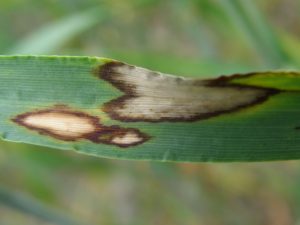Bulletin #1015, Barley Scald
Bulletin #1015, Barley Scald (PDF)
By Steven B. Johnson, Extension Crops Specialist, University of Maine
For information about UMaine Extension programs and resources, visit extension.umaine.edu.
Find more of our publications and books at extension.umaine.edu/publications/.

Barley scald is a common disease on barley in Maine as well as worldwide. It is caused by the fungus Rhynchosporium secalis. The pathogen can also attack rye and some other grasses. Scald is a fungal disease which can affect all above-ground portions of the plant. Most common in wet seasons, scald is potentially damaging to barley as it can prematurely kill leaves. Yield loss is primarily owing to reduced kernel weight, but the number of kernels and number of heads per plant may also be affected. Decreased photosynthetic area on the flag and second leaf of the infected plant may result in reduced seed weight and yield loss.
Biology
The scald fungus overwinters on barley residue, grain, and some grasses. In spring, spores are produced mainly from barley residue left on the soil surface from the previous year. Spores are transported to barley plants by raindrops and wind. The contribution of scald-infected seed as a source of disease spread in barley is not well understood. The disease is favored by cool (40°F to 75°F), rainy weather and dense crop canopies where leaves remain wet for prolonged periods. Optimal temperatures for sporulation and infection are 60°F to 68°F. If the disease appears and spreads early in the season, such as during tillering, yield losses may be expected owing to flag leaf infection. Late-season disease appearance rarely results in appreciable yield loss.
Symptoms

Large water-soaked spots, grey-green in color, appear on the leaves. These spots enlarge to lesions that are oval in shape with dark brown margins. The lesions become a bleached tan in the center. As the lesions enlarge, they coalesce to give a “scalded” appearance. Hot, dry weather halts disease progress.
Management
- Plant only certified seed of varieties adapted to the area.
- Plant less susceptible varieties, if possible.
- Properly fertilize the crop according to soil test recommendations.
- Plow under residue from previous barley crops.
- Avoid early planting if barley scald has historically been a problem.
- Rotate crops to avoid planting barley after barley.
- Use a seed treatment and a foliar fungicide.
- Keep weed grasses under control.
Thanks to reviewer David Fuller, Agriculture and Non-Timber Forest Products Professional, University of Maine Cooperative Extension
Information in this publication is provided purely for educational purposes. No responsibility is assumed for any problems associated with the use of products or services mentioned. No endorsement of products or companies is intended, nor is criticism of unnamed products or companies implied.
© 2014, 2020
Call 800.287.0274 (in Maine), or 207.581.3188, for information on publications and program offerings from University of Maine Cooperative Extension, or visit extension.umaine.edu.
The University of Maine is an EEO/AA employer, and does not discriminate on the grounds of race, color, religion, sex, sexual orientation, transgender status, gender expression, national origin, citizenship status, age, disability, genetic information or veteran’s status in employment, education, and all other programs and activities. The following person has been designated to handle inquiries regarding non-discrimination policies: Director of Equal Opportunity, 101 North Stevens Hall, University of Maine, Orono, ME 04469-5754, 207.581.1226, TTY 711 (Maine Relay System).

